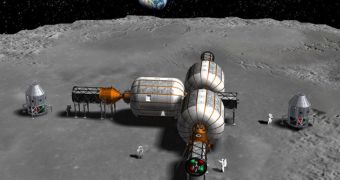Bigelow Aerospace is one of the most famous names in the private space industry. The company has pioneered a number of technologies related to exploring low-Earth orbit (LEO), and has even launched two prototypes of inflatable space modules, called Genesis 1 and Genesis 2. Now, space entrepreneur Robert Bigelow who founded the company in 1999 is looking a bit further, to creating a moon base. Engineers at the company say that the use of inflatable modules could make this a reality soon.
According to preliminary plans, the base itself will be assembled into space, in one of the Earth's five Lagrangian points. The Bigelow team also believes that a permanent resupply station could be constructed in one of these points, which could be permanently resupplied from Earth, allowing for non stop work on the Moon base. Once the structure – made entirely out of inflatable modules – is complete, astronauts could pilot it to the surface directly. This eliminates the need for cumbersome construction at the designated site.
“I see a huge sea change in using expandable systems. I feel this architecture is fundamentally safer, less expensive, and can save an awful lot of time,” Bigelow told Space in an exclusive interview. “We want to go to the moon […] and the expandable habitats are a good example of an enabling technology that will be leveraged to bring this vision to fruition. Our goal has always been beyond low Earth orbit,” said the director of Bigelow's Washington, DC Operations & Business Growth, Michael Gold.
“We need to make low-Earth orbit work first before we go beyond […] but I believe we will. Once we've established a robust infrastructure in Earth orbit, created the economies of scale necessary to produce facilities in low Earth orbit [...] at that point, we've really enabled ourselves to look at a variety of options,” Gold added. The representative mentions that the company has been actively involved in constructing an international consortium that could finance and back up such an endeavor in the long run. The decision to build the bases comes just as NASA plans to retire its Moon-bound Project Constellation.

 14 DAY TRIAL //
14 DAY TRIAL //